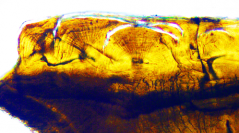

 Comptes Rendus Palevol
15 (1-2) - Pages 83-102
Comptes Rendus Palevol
15 (1-2) - Pages 83-102Ganoine is a different enamel from “true” enamel. The crystallites end in the middle of the projection of epidermal cell onto the ganoine surface. In contrast, “true” enamel shows the borders of the hexagonal epidermal cells. Cosmine is a combination of tissues (“true” enamel and dentine) and a structure (the pore–canal system). The pore–canal system opens in regular arranged pores on the scale surface and has a network of horizontal canals (mesh canals). Cosmine is limited to sarcopterygians possibly above actinistians and onychodonts, ganoine to actinopterygians. – Actinopterygian scales possess a narrow peg, an anterodorsal extended corner and ganoine either as overlapping or as multilayered enamel, whereas sarcopterygian scales have a broad based peg, no extended anterodorsal corner with two exceptions, but sometimes an anteroventral extension and cosmine. – The genera Andreolepis, Dialipina, Naxilepis, Terenolepis, Ligulalepis and Orvikuina are actinopterygians based on their scale characters. Additionally, Guiyu, Meemannia, Achoania and Psarolepis possess actinopterygian features. According to its scale characters Lophosteus is a stem osteichthyan.
Vertebrates, Early Osteichthyans, Actinopterygians, Sarcopterygians, Scales, Morphology, Histology